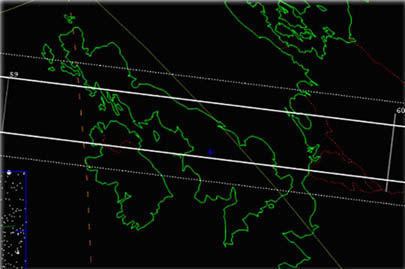2014 April 16
Friday April 18 – Large asteroid occults an 11th magnitude star
 There is an opportunity to make an interesting observation when the 184km diameter asteroid (241) Germania passes in front of (occults) an 11.6 magnitude star in Gemini on Friday 2014 April 18, at 20:59 UT (21:59 BST). The predicted track of the occultation passes NW to SE across the centre of the UK and Northern Ireland (see map). The occultation may be observable in some places, but not everywhere within this region. The maximum length of disappearance should be 8.5 seconds for someone in the centre of the occultation’s path.
There is an opportunity to make an interesting observation when the 184km diameter asteroid (241) Germania passes in front of (occults) an 11.6 magnitude star in Gemini on Friday 2014 April 18, at 20:59 UT (21:59 BST). The predicted track of the occultation passes NW to SE across the centre of the UK and Northern Ireland (see map). The occultation may be observable in some places, but not everywhere within this region. The maximum length of disappearance should be 8.5 seconds for someone in the centre of the occultation’s path.
As always, predictions of such events are approximate, and observers can contribute useful science by reporting whether or not they see the occultation. Observers reporting both positive (actually seeing an occultation) and negative (not seeing an occultation) results will help to map out the exact path of the event and size of the asteroid. Those who watch the star but don’t see it wink out should not forget to report a “miss” from their location.
The coordinates of 2UCAC 38779497 are:
| For date of event (2014) | RA 7h 7m 58″ | Dec 19d 33m 31″ |
| J2000 | RA 7h 7m 08″ | Dec 19d 35m 03″ |
A brighter field star HIP 34520 (v7.3) is about 0.5 degrees to the east of the target.
Finder charts at scales from 15 to 0.5 degrees can be found here:
http://www.asteroidoccultation.com/2014_04/0418_241_32426.htm
How do I observe and report what I see?
Find the star field as soon as it becomes dark with the aid of a planetarium program or the finder charts indicated in the link above.
With a suitable magnification, monitor 2UCAC 38779497 from 21:58 to 22:00 BST and note if the star disappears or not. An 8″ or larger telescope may be needed.
With the aid of a stopwatch and voice recorder, time the start and duration of the occultation. Start the stopwatch at the moment of disappearance and stop it on a precise UT second after the star reappears, preferably from a radio-controlled clock. The voice recording can then be replayed to obtain the exact reappearance time.
If you have a camcorder, set the internal clock to UT and use it as a voice recorder. Point the camcorder at a clock face, e.g. a radio-controlled clock (which automatically sets itself each day) and record your voice shouting ‘Out’ at the disappearance and ‘Back’ when the star returns. Observers familiar with video or CCD techniques can record a video of the event.
For more information on occultations, please see http://britastro.org/asteroids/Occultations.htm
When submitting observations, please report your name, location (latitude and longitude), telescope, timing method and event times to:
Tim Haymes, Assistant Director (Occultations)
Asteroids and Remote Planets Section
arps@britastro.org
| The British Astronomical Association supports amateur astronomers around the UK and the rest of the world. Find out more about the BAA or join us. |
